After Memories of Celceta sent me spiraling down an Ys hole, I knew I’d hit the bottom eventually. For me that meant playing through Ys Book I and II, a pair of games that really function as a unit, with the first one being originally released in 1987, which is only a year after The Legend of Zelda and marks it as part of the very first wave of action RPGs, with all the clunkiness and obscurity that entails. I don’t have a way of playing the very first release of Ys I and II, which were on obscure personal computers, though I could have played the Turbo Grafx-16 compilation of the first two games because I bought that Turbo Grafx-16 mini console, but I opted instead for the 2009 Steam version, which is itself based on a remake from 1997. This is a not quite 1 to 1 remake of those original games, with new graphics and a few gameplay changes, as well as a new translation that I have mixed feelings about. It does not have the voices that enthralled players from the Turbo release but what it does have, and the reason I bought it on Steam and played it as the first PC game I’ve played through in a couple years, is quick saves and loads. I knew that a game like this would be a painful experience without instant saving and loading, and though the Turbo Grafx-16 mini has save states I wanted the quick and familiar experience of PC saving. It took me a little while to configure the graphics correctly, and I never got it running in full screen, but even though this release is itself 12 years old it easily read my Xbox One controller and had a pretty much pain free experience playing through the two games. I should note that in addition to liberal save scumming I used a guide for certain parts of these games, which is something I rarely do. Even back in the 1980s I had little patience for the obscurity and opacity of these types of games, and in 2021 I just am not interested in sinking hours into puzzles and challenges that don’t make any sense. I did try to figure out everything myself, and for the most part I succeeded, but when I couldn’t figure out who to talk to or how to trigger progression I looked it up and I have no shame in it. This mostly consisted of looking up all the backtracking and looping around necessary for Darm Tower in Ys Book I, but there were a few other things. All the mazes and other challenges like that I did myself, and while I did look up boss strategies for a few bosses they were never helpful. I had already figured out what to do on them, I just had to git gud. Fortunately the boss fights in these games are so quick that you can get through over 100 attempts an hour, so it never took me more than 10-20 minutes to beat even the toughest bosses.

Ys Book I was a remarkable achievement for its time. It definitely shows its age, in every area, but playing it in the far flung future of 2021 you can easily see why it’s considered a foundational classic of the genre and spawned a series that continues even to this day. Ys Book I tells the story of Adol, a swordsman who washes up on the shore of an island and is nursed back to health by its inhabitants. They tell him about their troubles over the last 6 months, where their once peaceful mining land has been attacked by monsters, and a storm wall has risen up in the sea, preventing trade with the outside world. Adol must explore the island, figure out what’s causing these issues, and put a stop to the evil. Already this is an incredibly complex and robust story for a game this old. The Legend of Zelda just had a guy say “it’s dangerous to go alone, take this” but Ys 1 has towns to visit, people to talk to, and a true narrative. Even as far back as the Master System version (the first version released in the US) you could go into people’s houses and chat with them. I played PC games with this level of complexity back in this time period, but it was cutting edge storytelling for 1980s video games. This game came out before Final Fantasy, though it was a year after Dragon Quest.
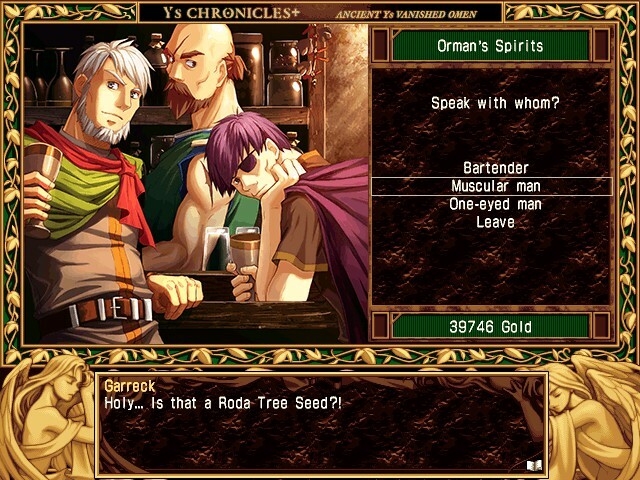
Of course Ys is not just a chatty adventure game, it’s an action RPG, and it has a very unusual combat system. There’s no attack button in these original Ys games, instead the game uses what is called the “bump combat” system. While you do equip various swords and armor and other items, attacking is doneby running into enemies, with face to face encounters doing a lot of damage to you, but attacks from an angle generally keeping you safe and annihilating the enemy. Ys combat is all about finding angles where you can bump your foe from a diagonal and kill them before they kill you. I had my doubts about this, and it’s the reason I never picked up the DOS version of the game in the 1980s, but it actually works reasonably well. Fights are fast and visceral, over in a matter of seconds or even less most of the time. Health is restored by standing around waiting (or with the one heal potion you can carry at a time in the first game) and everything flows well. In addition to equipment, the first Ys game does have a leveling system, though the maximum level is 10 and if you spend any time lost and wandering around, as I did, you’ll hit the cap early, well before you get to the massive dungeon that makes up the back half of the game.
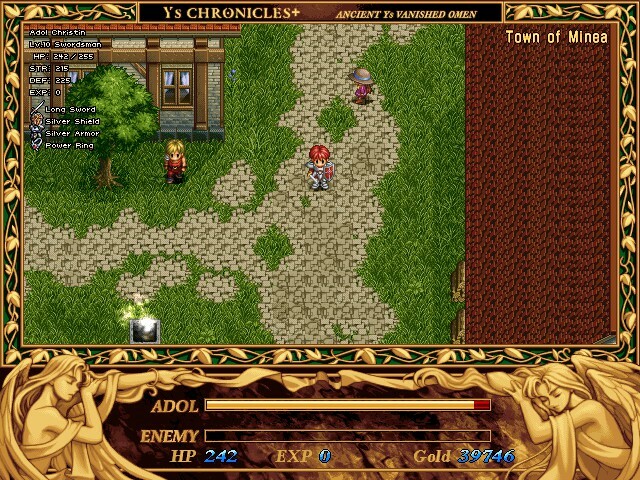
Ys Book I really is divided into two halves, each of which took me about 3 hours. The first is sort of a traditional action RPG with towns and fields and dungeons to explore. You walk around, meet people, figure out what to do, grind gold and experience to increase your level and get new weapons, go into a monster filled mine to find some items or a ruined temple to rescue a captive, that kind of thing. Your ultimate goal at this point is to collect three books of Ys, after which you will be able to get into Darm Tower to find the last 3. The second half of the game is scaling Darm Tower, a massive 25 floor dungeon full of traps, enemies, and even NPCs you can talk with. Once you enter the tower you cannot leave it again, which means you can’t return to town for any reason. Gold, which has been very important for buying equipment and consumables up to this point, becomes utterly worthless, and since you’re probably already max level, there is no point to fighting unless you need to advance. This means that the second half of the game feels pretty different from the first. The first half has a much more open feeling, with grinding and talking to people and going on quests interspersed with the combat. The second half is much more focused on puzzles and advancing through the tower, which sometimes involves backtracking once you get a certain item or to talk to people. I found the first half to be more fun because there was more variety and openness, but there is something satisfying to making your way through the massive dungeon of Darm tower and figuring out how to get past its various traps and dead ends. You do meet a few characters there, including series mainstay Dogi, so it’s not as lonely as many long dungeons can be, and there’s equipment to pick up from chests so there’s still a sense of advancement, but it still feels like a very different game.
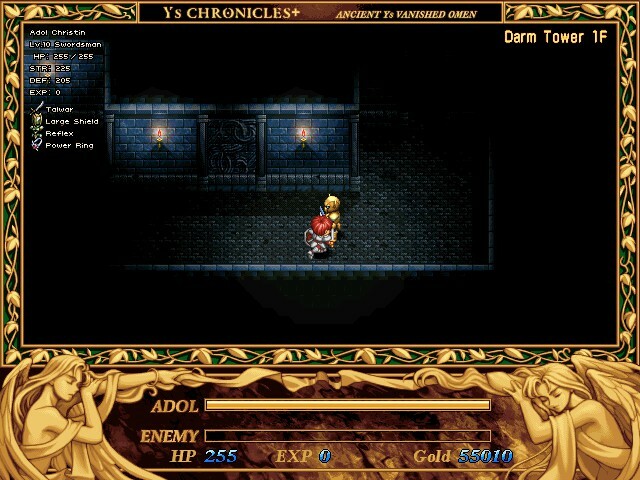
Overall Ys Book I is a primitive but still enjoyable experience. The story is not particularly compelling but was extremely sophisticated for the time, the combat is very unusual, which makes it interesting, the music is famously very good, and it’s not a punishingly difficult game, which was unusual for the time period. There are a couple bosses that are pretty unbalanced (both the bat boss and the final boss are extremely frustrating and unfair experiences) but otherwise, beyond the obscurity of what you have to do at times, there’s nothing too bad. Level design is very impressive for the time, with cool touches like a mirror maze and areas outside the tower where you can regenerate health even without the heal ring (which is a very useful item I found on my own.) The overly tough bosses and some poorly designed areas where you’re funneled into face to face combat (which doesn’t work well in this system) are a little annoying, but easy to overlook given the overall quality of the game. Little touches like being able to read the books you’re collecting are very cool and impressive for a time when most games had barely any story at all. I don’t know if someone who didn’t live through the 1980s and remember what it was like to play games at that time would get that much out of the experience, which is pretty simple, but I had a decent time with it.
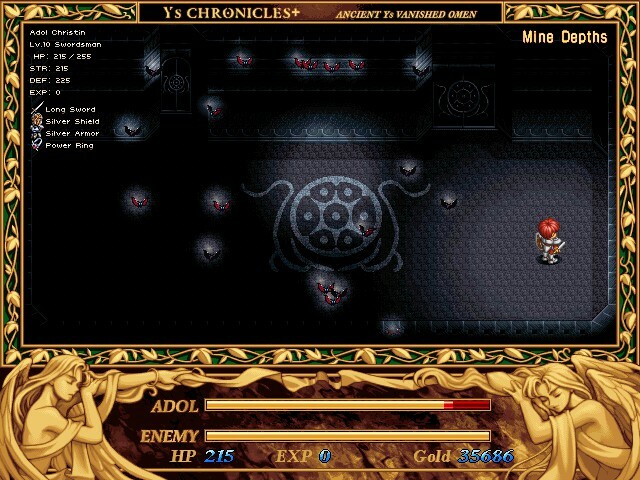
Ys II takes place immediately after Ys I and on the surface it’s a pretty similar game, but it is a massive step forward in both game design and narrative. Most people who have a fondness for these original Ys games got the two books packaged together and spent most of their time with Book II, which is about twice as long as the first game. It begins directly after the end of the original game, with Adol having reached the mythical land of Ys, waking up in another small town that directly mirrors the town from the first game and being tasked again with saving the land from the curse of monsters that has descended upon it. Adol again is set to level 1 and has to grind gold to get equipment, figure out where to go next, and in fact finds that his first quest involves disposing of the 6 books of Ys that he collected over the course of the first game by distributing them to the priests of Ys who each book represents.
The bump combat is back, but there are a couple major changes to it. The first is that this time you can get to levels above 50, and you never lose access to shops until the very end of the game, so there is always a reason to grind and fight enemies. This seems like a small tweak but it makes a big difference and keeps combat relevant through the end of the game. Leveling is extremely important in Ys Book II because of the way the game calculates damage, giving you bonuses for being higher level than your enemy and deficits for being lower. One boss fight towards the end of the game was taking me forever at level 37, to the point where it seemed legitimately broken. Spending some time grinding levels to get into the mid 40s made it one of the easiest fights in the entire game. Ys Book I’s much simpler and more limited leveling system didn’t allow for that kind of big swing, especially not later in the game when you’re already maxed out.
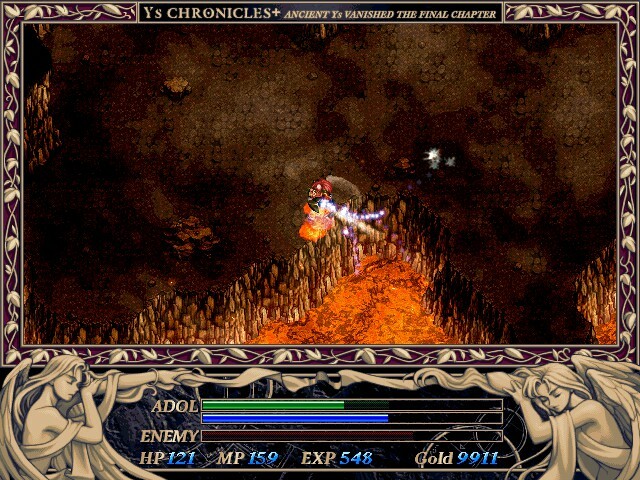
The bigger change is the introduction of magic. Adol can get 6 spells over the course of the game, including some utility magic like a spell that allows him to return instantly to any friendly area he has visited, and combat magic including a fireball spell that turns out to be the main way you fight bosses. Being able to shoot a projectile radically changes how the game works, as does a utility magic that allows you to travel around without enemies attacking you. Magic, along with the game’s much larger scope, has the effect of making Ys II feel like a much more modern game, even though it came out only a year later.

Ys Book II honestly feels like it could be a game from the 4th generation of consoles. This makes sense given that it was released the same year as the Mega Drive, but it has the design polish of game from the early 90s rather than the late 80s. The one area where I feel like Ys Book II really suffers is in its level design. To put it simply, much of Ys Book II is a series of giant mazes. This starts right away, as you explore another mine, much larger than the one in Ys Book I, and doesn’t let up until the final hour of the game. Most of your time will be spent trying to figure out how to get where you’re supposed to go, exploring a series of dead ends and confusing paths that involve weaving through numerous screens with unique paths. I never looked up a maze guide during my playthrough, and I spent a lot of time backtracking through the same screens over and over trying to remember the route to get back to an area I’d visited before. This gets especially bad once you get to Solomon Shrine, which like Darm Tower is a large unique dungeon where you’ll spend roughly half the game, though this time there’s a town outside the gates that you can return to in order to shop and talk to people, and do have to go back to sometimes in order to advance the game. It’s a massive, sprawling, complex with multiple wings that you unlock over time, but unlike the tower it’s not laid out in simple, comprehensible, floors. It’s very easy to get lost even in places you’ve visited a dozen times. While this does provide opportunities to grind, the temptation to just skip the encounters with magic is overwhelming, given how frustrating navigating these areas can be.
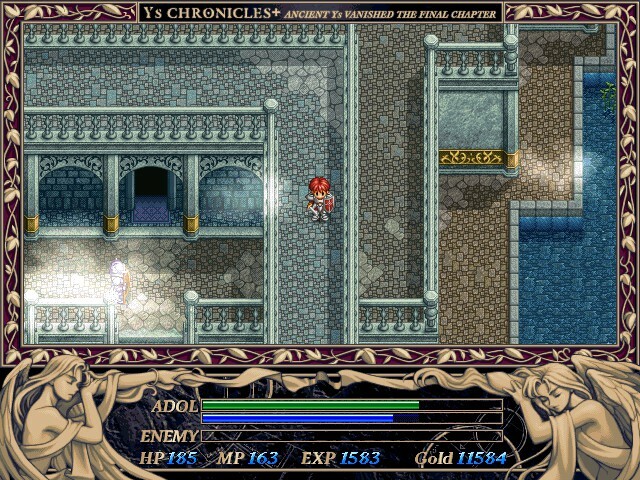
Ys Book II is a truly impressive game, if you can tolerate the mazes. The story and worldbuilding aren’t impressive by modern standards but are leaps and bounds better than the first game. The combat is still pretty fun and revolves around not just hitting enemies from an angle and pinning them to walls but also blasting them with fireballs this time. Bosses are generally less frustrating than the first game, especially because you can grind, and the fact that you have to use fireball spells to defeat them makes them feel different and more epic than the normal mobs in the game. The magic that lets you wander around unmolested is, frankly, a jaw dropping innovation for the time period and would have blown my mind with its implementation had I experienced it during the 1980s. The music is, again, a highlight.
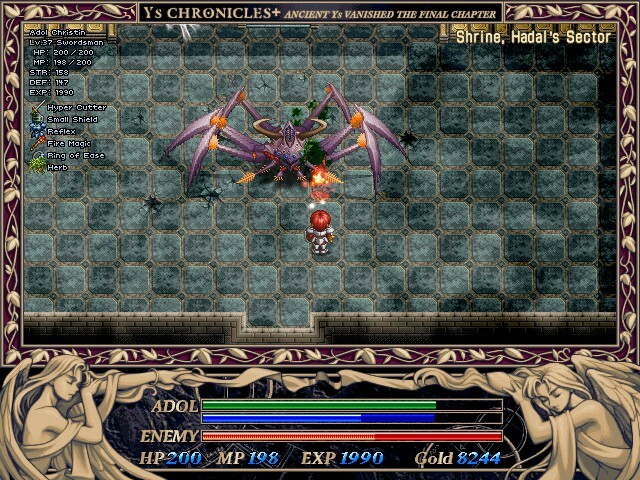
After playing through Ys Book I and II Chronicles can I recommend it to the modern gamer? Not really. These games show their age in a host of ways, and while they’re much better than the vast majority of games from the time period, they don’t really stand out in the modern context. This remake is, itself, showing its age and is kind of ugly, with a translation whose jokey tone doesn’t work well with the game’s overly serious storytelling (though some of that jokiness is definitely in the original games, such as with Dogi’s tendency to bust through walls.) These games are still kind of fun, and can definitely be appreciated if you’re the kind of person who’s interested in and appreciates old games, but while a lot of the lore and elements continue in the modern series they are not necessary to understand subsequent Ys games in any significant way. But I was sort of dreading my playthrough of these games, given their age, and was only doing it because of a compulsion to really explore this series and see why people loved it so much. These games definitely gave me that understanding. I honestly had a good time going through these games, warts and all, and Ys Book II especially left me consistently impressed and crystal clear on why so many people who played this on the Turbo Grafx CD in the early 1990s came away as fans for life. It’s not just because the anime cut scenes and impressive voice cast made them technical marvels, they’re actually pinnacles of game design given the time period. Bump combat is good, actually! Ys Book II is an astonishingly innovative game!
I can’t recommend these games just as games, but if you’re the right kind of weirdo they’re still playable and satisfying experiences. Frustrating at times, obviously old and clunky, but charming and wildly inventive. For everyone who has spent their whole lives having certain people who played these games in their youth telling them how wonderful they are and how Ys is amazing and underrated…you’ll understand what they were talking about after you play these games and why those obnoxious fanboys were actually kind of right.
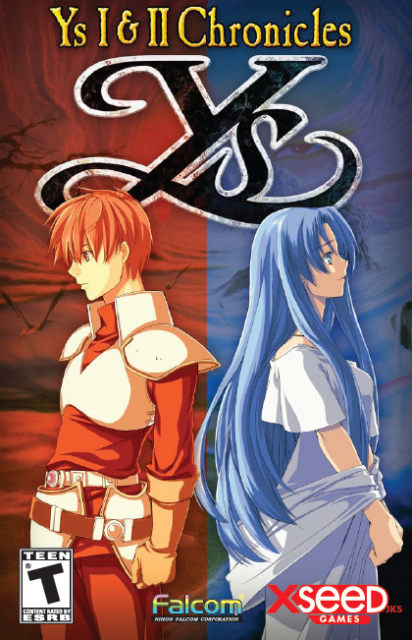
Log in to comment